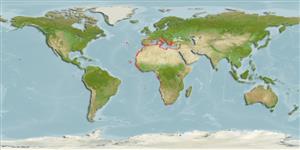Common names from other countries
Classification / Names / Names
आम नाम | उपशब्द | Catalog of Fishes (gen., sp.) | ITIS | CoL | WoRMS
Environment: milieu / climate zone / depth range / distribution range
पारिस्थितिकी
; गहराई सीमा 3 - 50 m (Ref. 417). Tropical; 46°N - 17°S, 18°W - 36°E
Eastern Atlantic and the Mediterranean: France south to Angola and east to Turkey.
Length at first maturity / आकार / वज़न / Age
Maturity: Lm ? range ? - ? cm Max length : 8.2 cm TL पुल्लिंग / अलिंग; (Ref. 104052)
Body length: 8 cm; Common body length: 3.0 to 6.0 cm (Ref. 417). Maximum depth from Ref. 79120. Intertidal (Ref. 122842), inshore (Ref. 105612) or along coasts (Ref. 78235). Found in an estuary (Ref. 122841). On sand (Refs. 417, 79120), mud (Refs. 417, 79383) and seagrass (Ref. 122842).
Life cycle and mating behavior
परिपक्व अवधि | पुनरुत्पत्ति | मछलीऔ का अंडे देना | अंडे | Fecundity | लार्वा
Members of the order Decapoda are mostly gonochoric. Mating behavior: Precopulatory courtship ritual is common (through olfactory and tactile cues); usually indirect sperm transfer.
Schneider, W. 1990. (Ref. 417)
IUCN Red List Status (Ref. 130435)
CITES status (Ref. 108899)
Not Evaluated
Not Evaluated
Human uses
मात्स्यिकी: लघु वाणिज्य
| FishSource |
साधन
अधिक जानकारी
Age/Sizeबाढ़Length-weightLength-lengthआकृति विज्ञानलार्वाबहुतायत
इंटरनेट स्रोत
Estimates based on models
Preferred temperature
(Ref.
115969): 16.5 - 27.4, mean 20.1 (based on 174 cells).
Vulnerability
Low vulnerability (10 of 100).
Price category
Unknown.
